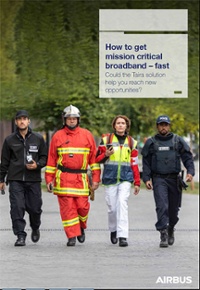Do you want to make a success of introducing mission-critical broadband to public safety? Learn the three important pointers to a successful project and get a tip on how to get started.
Broadband brings many new opportunities to public safety and other professionals. It is not surprising everyone wants to introduce it and as quickly as possible. But how to get to the brave new world of broadband and apps? What are the steps on the path to public safety broadband?
1. Get connectivity – and it has to be mission critical
Broadband connectivity is the first step. You can think of broadband use like driving, and connectivity – the access to broadband is the road. You need that before you can start driving.
For public safety, the road has to be just right. Think about access technology or how you "build the road" that is suited for you. Public safety users need mission critical broadband.
What is mission critical broadband?
To be mission critical, the broadband network needs to meet strict requirements for availability, reliability, and security.
- Firstly, there has to be enough bandwidth because that is the whole point of broadband.
- Availability and reliability requirements mean that your critical organizations have to be prioritized. If there is congestion or shortage of service, critical organizations will be served first. And in a worst-case scenario, pre-emption will step in. This means that other, lower-priority services will be cut so that critical users can get the service they need.
- Lastly, there has to be coverage. Critical users need to be able to work wherever, and to be able to work, they need to communicate. Therefore, their communications need to be available wherever. In some countries, this will require that extra coverage is built.

There is a difference between 5G and mission critical broadband.
5G stands for the fifth generation cellular standard. It enables broadband (wide bandwidth) networking. Mission critical broadband meets the strict requirements.
In other words, a commercial broadband network needs to deliver more than it does for the everyday consumers and their smart devices. Otherwise, it is not going to be mission critical.
So, how do you get mission critical broadband?
If there is a frequency licence, it is possible to build a dedicated mission critical broadband network. The current radio network operator or a Mobile Network Operator (MNO) may be in a position to build that.
There are also other options. For example a Secure Mobile Virtual Network Operator type of service. In this setup, a mission-critical Service Operator cooperates with one MNO or several MNOs – to get the data pipe or “the road” set up - and then offers broadband services to customer organizations.
Another option is a three-party model. The Service Operator uses a Mobile Virtual Network Enabler (MVNE) who takes responsibility for billing, network element provisioning, administration and other broadband-related tasks. The MVNE uses MNO services for broadband access.
The key point for organizations, however, is to get that Mission-critical Service Operator. That is the only way that organizations will have the availability and reliability that they need. As well as the security they need.
Handpicked related content
Not sure what a Service Operator is? Learn the ins and outs of Service Operators and find out why they are a good idea – download “Service Operators and critical communications - the essential guide”
2. Think beyond technology
It takes more than just getting the technology right to build public safety broadband successfully. The focus should not be on replacing the existing narrowband infrastructure.
Instead, your organization has to think about their needs. People will use smartphones, and they will need group communications. Therefore, you will want smartphones that are optimized to push to talk and push to data. Put a mission-critical push-to-talk, push-to-data and push-to-video into the smartphone and you will have your mission-critical smart device.
Because your teams have to be able to communicate, you will need to map the interactions. Which teams need to communicate together? Do they need to communicate with the control room? Is it all by voice or do they also exchange data? You need to map all of these things.

Here’s one risk you should not take. Even though you might think it’s a good idea to close down your existing system and move to a broadband-only network “to save money,” you may actually end up spending more. You may realize that the original system will be needed for a good few years yet.
Handpicked related content
How to plan for a hybrid approach when building broadband for public safety? Learn more and download this paper: "How to minimize risks when introducing mission-critical broadband".
So, even though many have adopted the public safety broadband network, some people will need to use the narrowband system. Find a push to talk solution that works between your narrowband system and the broadband and introduce it to the smartphone users. This way, you are connecting the old and the new.
3. Remember the added value
Any new solution must support how people work now, while also offering new capabilities.
Think about your use cases as they are now and define the 5 apps that are the most important. Your people are going to need those apps. A smart device is not going to be very smart if there are no apps inside!
But adopting new technology to do exactly the same as with the old would be stupid. And expensive! That’s why you need to define – or imagine – what you want that is new.

New things are an extension to how people work today – today’s business processes. Analyze those and figure out how people will want to work in the future. Think about what you need – likewise, think about what you don’t need!
A good place to start is by considering how things could be easier for the users. Much of the innovation could happen in user organizations because people tend to have ideas about how to do things more easily. Think about specific use cases: there may be an app or a feature in every one of those ideas.
You should also experiment.
Most people will only understand new capabilities when they can experiment on them. Those who are reluctant to change will find it easier to adopt new things when it is only a test. They can be reassured, and everyone will get a more realistic idea of what is possible.
An important tip
If you have not started on building your public safety broadband, you should start right now. Get the mission critical connectivity, make sure you have suitable smart devices, and plan how to get the necessary things you have now and how to get some new capabilities. If you don’t get a move on, you will not be any closer to broadband in five or ten years!
The time to move is NOW.
Perhaps this makes you nervous or edgy? But find a friendly operator, integrator or other partner to make your journey easier. For example Airbus can help you build public safety broadband.
Start your journey and you will build your in-house competences while moving to the right direction. You can prepare for what is beyond your current, narrowband system. Because the beyond will come.
This white paper describes the fastest route from your narrowband legacy communications to 5G and beyond. Could the Taira solution help you reach the new opportunities you are looking for?
Download now: “How to get mission critical broadband – fast”





